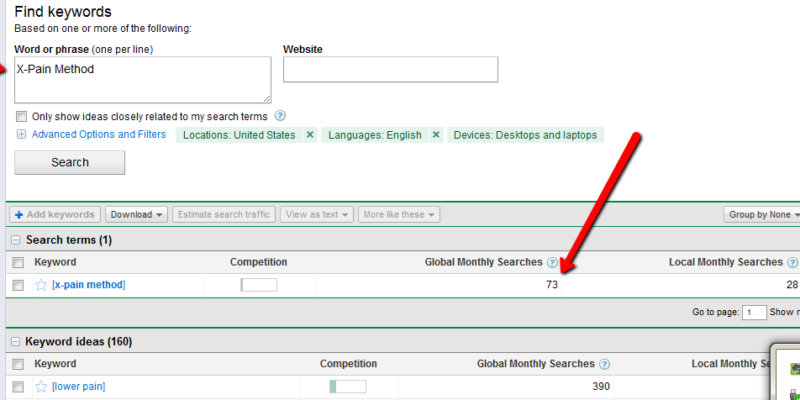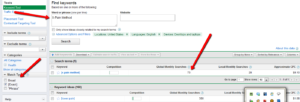Please email me at:
Or use the form below.
[contact-form 1 “Contact form 1”]
The no-pants guide to spending, saving, and thriving in the real world.

In this installment of the Make Extra Money series, I’m going to show you how I do keyword research.
Properly done–unless you get lucky–this is the single most time-consuming part of making a niche site. If you aren’t targeting search terms that people use, you are wasting your time. If you are targeting terms that everybody else is targeting, it will take forever to get to the top of the search results.
Spend the extra time now to do proper keyword research. It will save you a ton of time and hassle later. This is time well-spent.
If you remember from the last installment, when we researched products to promote, we narrowed our choices down to a few products.
What I’ve done is create a spreadsheet to score the products. You can see the spreadsheet here. I’ll explain the columns as we populate them.
The first column contains the name of the product. Easy. We’ve got 10 products. I’m going to walk through scoring 1 product, then, through the magic of the internet, I’ll populate the rest, and you’ll get to see the results instantly. Wow.
The second column is the global search volume for the exact search term. I base my product niche sites primarily on the demand for a given product. Everything else is a secondary consideration.
To find the demand for a product, go to the Google Adwords Keyword Tool. In the “word or phrase” box, enter your product name, exactly. In this case, it’s “X-Pain Method”. When the search results come up, change the match type to “Exact”. You should have something like this:

Enter the global search volume in column 2. In this case, it’s 73. Keep this window open, because we’ll be coming back to it.
Column 3 is the search competition. Go to google and enter your product name, in quotes. In this case, “X-Pain Method”. Put the total number of search results in column 3: 223000.

Column 4 is the search competition, but only what appears in a page’s title. Your search query is intitle:”X-Pain Method”, which yields 4400 results.
The next column is for the average PageRank of the first page of search results. For this, I use Traffic Travis. I use the 4th edition, which is paid software, but you can get the free version of version 3, instead. I’ll use version 3 for this example. Open the software and click on “SEO Analysis” on the bottom left of the screen. Put your search term (“X-Pain Method”) in the “phrase to analyze” and set the “Analyze Top” to 10, then hit “Analyze”. When it’s done running, just add up all of the PRs and divide by 10. Ignore Travis’s difficulty rating.
Now, for the rest of the columns, we’re going to look at the keyword tool again. We’re going to pick 3 alternate search terms. Here are the criteria:
Once we pick the keywords, we’ll throw them into google to get the competition, just like we did to populate column 2.
“Exercises for back pain” has medium competition and 1900 monthly searches. It also has an estimated cost-per-click of $3.02, which means people are paying for this.
“Lower back pain exercises” has 6600 searches and medium competition. It’s actually on the lower end of medium, so it looks really promising.
“Lower back” has 4400 searches and low competition, with a CPC of $6.24. This should be a good one. Scratch that. It has 40 million search results, but only 4400 searches. That’s a lot of competition for a small market.
Instead, I’m going to search for “cure back pain” in the keyword tool and see what I get. “Upper back pain” is better. Low competition, 18000 searches each month, and only 2000000 competing search results. Now, I’ll score it.
You really want at least 500 searches per month for the product name. More than 2500 is better. I’m going to assign 1 point per 500 monthly searches.
You also want a lower number of search results. Less than 10,000 is ideal. Less than 100,000 is still decent. More than 250,000, I’d walk. So, under 10,000 gets 5 points. Under 50,001 gets 4. Under 100,001 gets 3. Under 200,001 gets 2. Under 250,001 gets 1. Any higher gets 0.
The ideal intitle search will have less than 2000 results. More than 100,000 is too time-consuming to deal with. 0-2000: 5 points; 2001-10,000: 4 points; 10001-25000: 3 points; 25001-50000: 2 points; 50001 to 100000: 1 point.
The perfect product will have the first page of search result all with a PageRank of 0. That’s a 5 point product. I’ll knock off half a point for every point of average PR.
The related terms are more relaxed. They are what’s known as “Latent Semantic Indexing” (LSI) terms. We will be creating articles to match those search terms, mostly to make our niche site look as natural and real as possible. Any actual traffic those pages drive is just gravy. Points for the related searches start at 10 and get 1 point knocked off for each 3 million results. We’ll be treating the 3 terms as one for this score.
That gives us a perfect score of about 25. There’s no actual upper limit, since the score for the search volume has no upper limit. X-Pain Method scored 18.22.
Now, excuse me a moment while I score the rest.
I’m back. Did you miss me?
I’ve finished scoring each of the products and sorted the results by score. The clear winner is the back pain product, but the lack of searches bothers me. The wedding guide looks much nicer, especially if I target the phrase “wedding planning guide” during the SEO phase of the project. That change alone brings the score almost to first place.
Frankly, I’d take either 2nd or 3rd place over the back pain product. The bare numbers don’t support it, but my judgement tells me they are better products to promote.
There is one final step before deciding on the product. I have to buy it. I can’t review the product without seeing it and I can’t promote it without approving of it.
That’s the secret to ethical niche marketing, you know. Only promote good products that you’ve personally read, watched, or used.

Even as a growing number of analysts are questioning the details of Obamacare, the sudden hospitalization of Teresa Heinz Kerry, the wife of former senator and current U.S. Secretary of State John Kerry, provides additional fodder to the ongoing healthcare debate.
Heinz, who is 74 years old, is the heir to the Heinz ketchup fortune. She is the widow of former Senator John Heinz, who was killed in 1991 in an aviation accident. Her marriage to Kerry in 1995 occurred when he was the senator from Massachusetts. Heinz was hospitalized on Sunday and is reported to be in critical condition after being flown to Massachusetts General Hospital in Boston.
Heinz was treated for breast cancer in December 2009 and went through two operations for lumpectomies. It is not known what specific health issues resulted in the current hospitalization. However, sources indicated that there was concern over the return of the cancer.
Regardless of the source of the current illness, it is taken for granted that Heinz will receive the very best of medical care, with cost being of no concern to treatments pursued. In the earlier process of treating her cancer, numerous doctors at the nation’s finest medical facilities were consulted. The issue of Heinz not having to worry about the costs of her care is the central theme of many who criticize our nation’s health care system.
For the millions of Americans who live daily without health insurance or any form of coverage, there is a constant concern over how they would deal with a medical emergency. These individuals know that they are one accident or serious illness away from devastating financial hardship. In fact, the single biggest reason for bankruptcy in the U.S. today is medical bills. According to the latest studies, the average hospital stay billed out at $15, 700, with an average daily cost of nearly $4,000.
These costs are onerous because so many people today find health insurance increasingly unaffordable. While the political debate over the current healthcare reform continues, there is one simple fact. That reality is that the annual cost of private health insurance, already out of the reach of many, has risen by as much as 50 percent in the last two years. Many plans for a family of four are now over $15,000 and it is predicted that a bronze plan under the implemented Obamacare will exceed $20,000 for that same family.
All of this brings us back to the hospitalization of Heinz. The reality we live in today means that many people diagnosed with cancer or other similar diseases have little hope of receiving the treatment or care that the wealthy can afford. Even with quality health care insurance, the co-pays and other costs create burdens that many cannot carry.
There are no simple or ready solutions to this situation. The morality of one patient dying because chemotherapy is too expensive while one with a large bank account survives is an issue that will see intensified debate in the coming months and years. Regardless of what caused the current hospitalization, Heinz is one of the lucky ones who will have superb medical care without financial considerations.
There’s a saying that you are the average of your 5 closest friends. Take a look at the people you hold dearest. Combined, they are you. If they are all in debt, chances are, so are you.
As a corollary, you are a part of your friends. If you become more financially responsible, it will rub off on the people who care about you.
Given these two rules, one way to improve yourself is to help those around you improve themselves. If your influence convinces your friends to move closer to your ideal, it will be easier, almost effortless to move closer to it, yourself.
It sound manipulative, but if you are manipulating your friends, you are doing it wrong. Don’t try to force or trick your friends, just be honest and sincere in your efforts to help. Nobody wants to be in debt. This is you being nice.
While it is okay to splurge occasionally, don’t be afraid to suggest less expensive activities. If someone suggests going to a movie, mention the dollar theater. If they want to go out for dinner, offer to host a potluck. Trip to the casino? Game night at your house. There are almost always cheaper ways to have fun. As long as you are spending time with the people you love, you’ll have a good time. Do you really need to drop $100 to do that?
If you buy an iPod and immediately run to show it off, you are going to trigger a case of “keeping up with the Joneses”. If your friends spend all of their time around people who are constantly buying expensive toys, buying expensive toys becomes normalized in their minds. Debt becomes the norm. Then extreme debt. Don’t reinforce the destructive debt cycle by showing off the expensive trophies of excessive, unnecessary consumerism.
This is a fine line to walk. If mention how much money your friend is wasting on 13 shot venti soy hazelnut vanilla cinnamon white mochas with extra white mocha and caramel every single morning, you’re going to get annoying fast. In fact, you are already annoying me, so knock it off. On the other hand, if Caribou is having a sale on the 13 shot monstrosity, speak up. Nobody is going to complain about getting a $15 coffee for less than $10.
If you’ve got a friend who’s into landscaping and you’ve got a neighbor who needs a landscaper, make the connection! If you know a web designer and a business in need of a website, get them together. Do what you can to match the needs of the people around with each other. They will all appreciate it, and everyone will be better off. Be the guy who helps everyone connect with the people they need.
Put another way, don’t be a dick. Nobody likes being nagged. Nobody likes being told they are doing everything wrong. Be encouraging, not mean.
If you can do all of that, it’s natural that your friends will start acting the way you want yourself to act. The less they want to waste on a trip into debt, the less tempted you will be to do the same.
Frugal cooking can be an intimidating concept. It’s easy to turn a meal into a huge expense, but it’s not that hard to trim your grocery budget without sacrificing variety and flavor. It just takes some planning and a few money-saving techniques. We usually feed our family of five, often with guests, for about $100 per week.
Schedule your meals. Find or make a weekly meal planner. I recommend this or this. Cross out the meals you don’t need to worry about due to your schedule that week. If you won’t be home, you don’t have to cook that meal. Fill in the meals in the remaining slots. Keep your schedule in mind. If you get home from work at 5:30 and have to be somewhere by 6:30, dinner needs to be something quick. Also, make sure you include every side dish you will be serving. Now, look at the recipe for each dish in every meal. Write down everything you need to make all of the food you plan to eat that week. While planning your meals, think about how to use your leftovers. If you cook chicken breasts one day, the leftovers can be chicken nuggets the next.
Take inventory. Take your meal plan and a pen while you look through all of your cabinets and your refrigerator. Why buy what you already have? If you already have steaks in the freezer, don’t waste your money buying more. If you have it, cross it off of your meal plan shopping list. Whatever is left is your shopping list. Review it. Is there anything that can be combined or eliminated? Is there a key ingredient for a sauce that’s missing?
Don’t forget the staples. If flour or sugar is on sale, stock up. Anything you use on a regular basis is a staple, buy it when it’s cheap.
Build a shopping list from your meal plan. When you are in the store, stick to your list. It’s hard, but avoid impulse purchases at all costs. Don’t shop hungry, don’t buy things just because they are on sale, and don’t dawdle. Get what you need and get out.
Avoid pre-processed food. We slice and shred our own cheese. Buying the pre-shredded cheese costs an extra $5 and saves just 5 minutes. Don’t buy pre-sliced apples or anything that will only save a few minutes for several dollars of cost.
Every couple of weeks, I cook a large pot of either beans or rice and keep it in the refrigerator. Almost every meal that we cook gets a cup or two of beans or rice added to it. It doesn’t alter the flavor much, but it adds a few extra servings for pennies. It’s a healthy way to stretch any meal on the cheap.
We have a large bowl in the refrigerator filled with mixed greens. We buy whatever salad-like greens are on sale and prepare the large salad all at once. Most meals start with a salad, which makes it easier to fill up without relying on the protein dish, which is generally the most expensive part of a meal. As a dedicated meat-eater, it took some getting used to, but it’s a good meal–cheap and healthy.
Cook enough for at least 3 meals. That will eliminate 2/3 of the work involved in cooking. Plan ahead to make your meals simple and easy.
Freeze the leftovers in usable sizes. Stock up on semi-disposable meal-sized containers. Freeze some in single-serving sizes for work, and others in family-size servings for last minute meals at home. Preparing for last minute meals keeps you from serving garbage or takeout when life gets in the way of your plans.
Avoid wasting leftovers. Wasted food is wasted money.
When you are done cooking meat, take any drippings or scraps and throw them into the slow-cooker along with any vegetable scraps laying around. Cook it overnight, then strain it into an ice cube tray. You now have stock/broth ready to be added to any recipe.
Plan for serial meals. Chicken breast leftover from today’s meal can become chicken nuggets tomorrow, to be shredded into chicken salad the next day.
When there isn’t enough left for a full serving, we put the remains in a resealable bag in the freezer. When we accumulate enough to fill our slow-cooker, we dump in all of the bags with a couple cups of water. I look through the refrigerator for any leftovers that have been overlooked that week or any vegetables getting close to being too old. It all gets cut up and added to the cooker to cook on low all day. I rarely add seasoning because everything going in the pot tastes good. We never get the same meal twice and our “free soup” is never bland.
That’s how we cook cheap, without sacrificing too much time. How do you save money cooking?
This post is a blast from the past. Originally posted here in January 2010.

For the last year or so, I haven’t been writing much, which feels weird. I used to write three timer per week. I’d write about saving money, investing, frugality, sometimes, relationships and parenting.
But that stopped. Why?
When I started this site, I was about $110,000 in debt, and just starting my journey out of it. A few months before, I was looking into bankruptcy, because I didn’t know how to get out of debt.
For years, the ways I saved money, cut corners, and earned extra money was fodder for this site. Everything I did was about saving money, earning money, and paying off debt.
Now? I’m about 2 months away from being completely debt-free. I paid my mortgage off last month, and have about $10,000 in credit card debt at the moment. I know, I paid that off backwards, but there are reasons. Reasons I’ll share another time.
4 years ago, I was essentially working 4 jobs. My day job, my gun training business, my internet marketing business, and my websites(including this one). I was working all of the time. It was necessary, but it’s a path to burnout. Then, I changed jobs a couple of times, nearly doubling my day job’s pay. My business partner got promoted out of a position that generated leads for one of our businesses, then had an accident that the other shared business on hold for a while.
Suddenly, I had free time and enough money coming in that I didn’t need to work all of the time. It was a crazy place to be after spending more than a decade pretending to be a workaholic just to keep my head above water. (Here’s a secret: I’m incredibly lazy. I’m just the busiest lazy man I know.) So I started pursuing hobbies.
Linda and I have been taking ballroom dancing lessons and are nearly to the point that competing is a real possibility.
I cleaned out my garage and assembled a decent wood shop, which is something I’ve wanted to do roughly forever.
I’ve been taking blacksmithing lessons with my teenage son.
I’ve been playing games with my kids, dating my wife, and simply enjoying my life.
This site?
Through all of that, I haven’t known what to write about.
“Dear audience, this month, I paid my bills, didn’t go on vacation, and bought a drill press.”
“Dear audience, my debt went down another $500 this month.”
“Dear audience, I didn’t buy a car I can’t afford this month. Again.”
Those aren’t good articles. Financially–while paying off debt is disturbingly exciting–my life is very repetitive. That’s the hardest part about paying off a lot of debt. It’s good, it’s necessary, it’s boring. My wins have been spaced out by several years lately, and I haven’t been creatively frugal. Screw frugal. If you can afford some conveniences and luxuries, frugal sucks.
Anything new happening in my world that would apply to this site would make it read like an accountant’s ledger book. $100,000 minus $1500 plus $10,000 minus $300, ad nauseum.
Instead of inflicting boring accountancy on you, I’ve been absent.
What next? Who knows. I enjoy writing. I enjoy writing here. I’ve started writing a novel.
What would you like to see here?